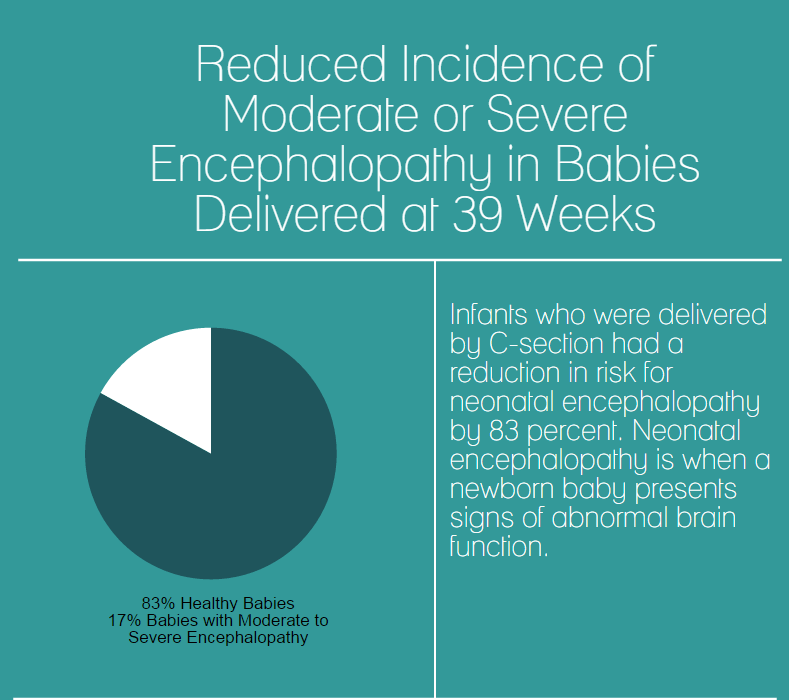According to a 2006 study by obstetricians and gynecologists Gary D. Hankins, MD, Shannon M. Clark, MD and Mary B. Munn, MD, planned elective cesarean sections can significantly reduce the risk of birth injuries. The doctors studied over 2,100 articles from the national library of medicine. They searched for the following terms: fetal trauma, shoulder dystocia, brachial plexus palsy, neonatal skull fracture, obstetrical trauma, traumatic delivery, intrauterine fetal demise, stillbirth, fetal demise and neonatal encephalopathy. The doctors concluded that elective cesarean section at 39 weeks gestation can significantly reduce the risk of neonatal encephalopathy shoulder dystocia, fetal trauma and intrauterine fetal demise.
Neonatal Encephalopathy
Neonatal encephalopathy is when a newborn baby’s brain function is disturbed. Hypoxic ischemic encephalopathy (HIE), a lack of oxygen and reduced blood flow to the brain, is the most common cause of neonatal encephalopathy. In their study, Dr. Hankins and his colleagues found that elective C-sections performed at 39 weeks would avoid 83 percent of moderate or severe neonatal encephalopathy.
Signs and symptoms for neonatal encephalopathy include:
- Low Apgar scores
- A weak or absent cry at delivery
- Seizures
- An abnormal level of consciousness
- Hypotonia (limp or floppy baby)
- Hypertonia (the baby is stiff)
- Apnea (the baby stops breathing for periods of 20 seconds or more)
- Feeding difficulties
- Respiratory problems (could be on a breathing machine)
- Fever
- Organ failure
- Hyper or hypoglycemia (blood sugar problems)
- Stiff neck from meningitis or meningoencephalitis
Shoulder Dystocia
Shoulder dystocia occurs when the baby’s shoulder is hinged or gets stuck on the mother’s pelvis during delivery. Shoulder dystocia often causes brachial plexus, an injury to the nerves that control the shoulder, arm, hands and fingers. In their study, Hankins and his colleagues found that elective C-sections at 39 weeks reduce the risk of shoulder dystocia.
Risk factors for shoulder dystocia include:
- Fetal macrosomia (large baby)
- Maternal diabetes
- Maternal obesity
- The use of forceps or vacuum extractors during delivery
Fetal Trauma
Fetal trauma can happen for a variety of reasons. However, the misuse of forceps and vacuum extractors are often the cause of significant birth trauma. These instruments are specifically associated with high rates of birth injuries. In operative births (cases where instruments were used), traumatic cranial and cervical spine injuries are still occurring. Injuries also occur as a result of persistent attempts to deliver the baby vaginally, even without the use of forceps or vacuum extractors. The study by Dr. Hankins and his colleagues found that elective C-sections at 39 weeks reduce the risk of fetal trauma.
Birth injuries associated with fetal trauma include:
- Hypoxic ischemic encephalopathy (HIE)
- Cerebral palsy
- Intracranial hemorrhages/brain bleeds
- Erb’s palsy
- Subgaleal hemorrhage
- Symptomatic ICH
- Subdural hemorrhage
- Facial Nerve palsy
- Brachial plexus
- Phrenic nerve injury
- Laryngeal nerve injury
- Nasal septal dislocation
- Significant ocular injuries
- Femoral or humeral fracture
Intrauterine Fetal Demise
Intrauterine fetal demise, or stillbirth, can also be prevented by C-section. Stillbirths occur in one percent of all births. According to the study, a significant increase of stillbirths occurs after 39 weeks. It is estimated that C-sections can prevent two fetal deaths per 1000 live fetuses. This means that 6,000 babies could be saved in the U.S. annually by use of elective C-section at 39 weeks as the preferred birthing method.
Risk factors for intrauterine fetal demise include:
- Intrauterine growth restriction (small baby)
- Preeclampsia (hypertension)
- Eclampsia (seizures)
- Abnormal fetal testing
- Thrombophilia (blood clots)
With regard to these four birth injuries, the doctors proved that within every case, lives could have been saved if C-sections were more commonly used. The doctors concluded that mothers should know and understand this study in order to make future informed decisions about childbirth. C-section deliveries that are performed electively at 39 weeks reduce the risk of neonatal encephalopathy, permanent brachial plexus injury, physical trauma to the baby, long-term neurologic impairment, intrapartum death and intrauterine fetal demise.
Gary Hankins is Vice Chair of the ACOG Task Force on Neonatal Encephalopathy. Neonatal Encephalopathy and Neurologic Outcome, ACOG, March 2014, p. vii. See Hankins GD, Clark SM, Munn MB: Cesarean section on request at 39 weeks: impact on shoulder dystocia, fetal trauma, neonatal encephalopathy, and intrauterine demise, Semin Perinatol 2006 Oct;30(5):276-87.
If your child was born with HIE, neonatal encephalopathy, shoulder dystocia or other birth injuries, call us to find out if you have a case. At Reiter and Walsh PC, we have the experience and knowledge to win your case. For a free case review, please contact us in any of the following ways:
Call us toll-free at 888-419-2229
Complete our online contact form
Click the Live Chat tab to the left of your screen
